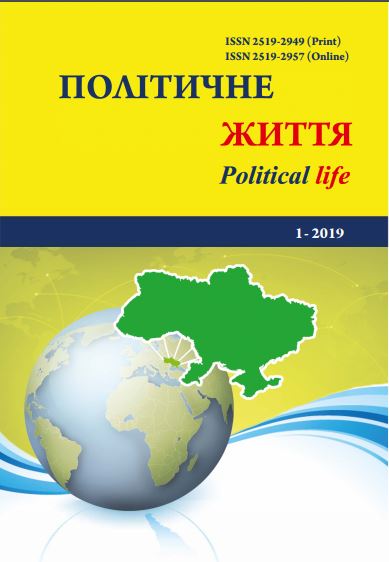Ternopil CPU regional committee before on the eve of restoration of Ukraine state self-governance.
DOI:
https://doi.org/10.31558/2519-2949.2019.1.5Keywords:
CPSU-CPU, communist centers of Ternopil region, reduction, national liberation movement, State Committee on the State of Emergency, statehoodAbstract
In order to prolong the Russian imperial tradition in a new format, at the beginning of the twentieth century. Small marginal union of the Bolsheviks instrumentally used the communist doctrine and made a coup in Pertograd. It’s postulates were applied not only to the usurpation of power in Russia, but also for the annexation of neighboring states that have just proclaimed independence. Among them also was destroyed by Russian Bolsheviks the Ukrainian People’s Republic. Thus, the ideology of communism in the USSR was transformed into a dogmatic doctrine, which enabled the functioning of the state under the conditions of internal support of the security forces and aggressive foreign policy. Strength Union, which formed the political core of the country was the ruling CPSU and its republican units, such as the Communist Party, considered as a whole.
Throughout the century, Communist Party autocracy has caused a significant number of political, socio-economic, national and religious problems, which cast doubt on the viability of the communist doctrine as a state ideology. Being the initiator of numerous crimes, the party turned into a deep-seated bureaucraticloke state structure, which, as a result of the destructive action of the key party principle of «democratic centralism», ceased to be a voluntary union of like-minded people. She rigorously controlled all aspects of the life of a multi-ethnic and multi-religious Soviet society. In the political context, the democratic foundations of the councils of people's deputies were replaced by the leadership of the CPSU, in the economic segment, the planned market economy replaced market instruments, in the national segment there was a total russification of annexed societies; the religious segment was dominated by the ideology of atheism.
At the end of the century, the synthesis of these permanent problems in the USSR gained such a «critical mass» that it was impossible to conceal. The CPSU became a key brake on the steady development of not only scientific and technological progress, but also the social development of the country as such. Caused by the party low material status of citizens in symbiosis with politic al injustice, national pressure and religious persecution turned into an «explosive mixture» which could deprive the party of its monopoly position, and therefore cause a collapse of the state, where the Russian ethnos was dominant.
As a result, in 1985-1991, the Communist Party topped the «cosmetic repair» of the first economic, and later the political core of the country, calling it «perestroika». In fact, it was a partial «annex» of democratic and market methods to the autocratic and planned background of the Soviet Union. In the opinion of the Central Committee of the CPSU, «perestroika» was to distance the party from Stalin's atrocities, to renew its social status, to increase the powers of the Soviet institutions, to prevent a growing economic crisis, to resolve national and religious problems, and most importantly, to maintain its own pro-government positions. Therefore, the leadership role in the Soviet society of the CPSU remained in its place.
However, the natural incompatibility of democracy and autocracy, the market and the plan naturally weakened the communist regime, led to the disintegration of the regional Communist Party cells, restored the national liberation movement and accelerated the collapse of the USSR. On the eve of its fiasco the brightest examples of intraparty decay were illustrated by the regional committees of the western regions of the Ukrainian SSR, among which the most notable was the cessation of the activities of the Communist Party organization of the Ternopil region.
References
Баран В. К. Україна після Сталіна: нариси історії 1953-1985 рр. Львів: МП «Свобода», 1992. 124 с.
Батенко Т. Опозиційна особистість: друга половина XX ст. Політичний портрет Б. Гориня / Т. Батенко. Львів, 1997. 305 с.; Батенко Т. «Я повстаю, отже, я існую». Політичний портрет Івана Геля. Львів, 1999. 222 с.
Гадомський О. Замітають сліди. Тернопіль вечірній. 1991. 24 серпня. С. 2.
Голос народу. 1991. 24 серпня. С. 2.
Голос народу. 1991. 27 серпня. С .1.
Державний архів Львівської області. Ф. 3. Оп. 62. Спр. 974. Арк. 101.
Державний архів Тернопільської області (далі ДАТО). Ф. 3. Оп. 29. Спр. 21. Арк. 4.
ДАТО. Ф. 1. Оп. 39. Спр. 126. Арк. 11.
ДАТО. Ф. 1. Оп. 39. Спр. 129. Арк. 125.
ДАТО. Ф. 1. Оп. 39. Спр. 131. Арк. 21–22 .
ДАТО. Ф. 1. Оп. 39. Спр. 132. Арк. 10–15.
ДАТО. Ф. 1. Оп. 39. Спр. 137. Арк. 13.
ДАТО. Ф. 1. Оп. 39. Спр. 141. Арк. 2.
ДАТО. Ф. 1. Оп. 39. Спр.150. Арк. 18.
ДАТО. Ф. 1. Оп. 39. Спр. 347. Арк. 14.
ДАТО. Ф. 146. Оп. 16. Спр. 24. Арк. 9.
Кульчицький С. В. Партійно радянський апарат у системі влади. Український історичний журнал. Київ, 1994. № 6. С. 3–15.
Кучер П. За суверену соціалістичну Україну в оновленому Союзі. Новини Шумщини. 1991. 26 лютого. С. 3.
Муравський О. Західні землі України: шлях до незалежності (1985 – 1991). Львів: Інститут українознавства ім. І. Крип’якевича НАН України, 2011. 268 с.
Сеник Л., Якимович Б. Форпост незалежності (Львів у 1988 – 1996 рр.). Львів: Друкарня оо. Василіан «Місіонер», 1996. 638 с.
Тарасенко В. На волю запрошень не дають. Тернопіль вечірній. 1991. 28 серпня. С. 3.
Тернистий шлях. 1991. Серпень. С .2.
Тернопіль вечірній. 1991. 1 травня. С. 1.
Тернопіль вечірній. 1991. 15 червня. С. 1.
Тернопіль вечірній. 1991. 21 серпня. С .1.
Тернопіль вечірній. 1991. 24 серпня. С .1.
Тернопіль вечірній. 1991. 29 серпня. С. 4.
Трудова слава. 1991. 23 січня. С. 1.
Трудова слава. 1991. 27 серпня. С.1.
Філяк Ю. Заява. Голос народу. 1991. 24 серпня. С. 1.

